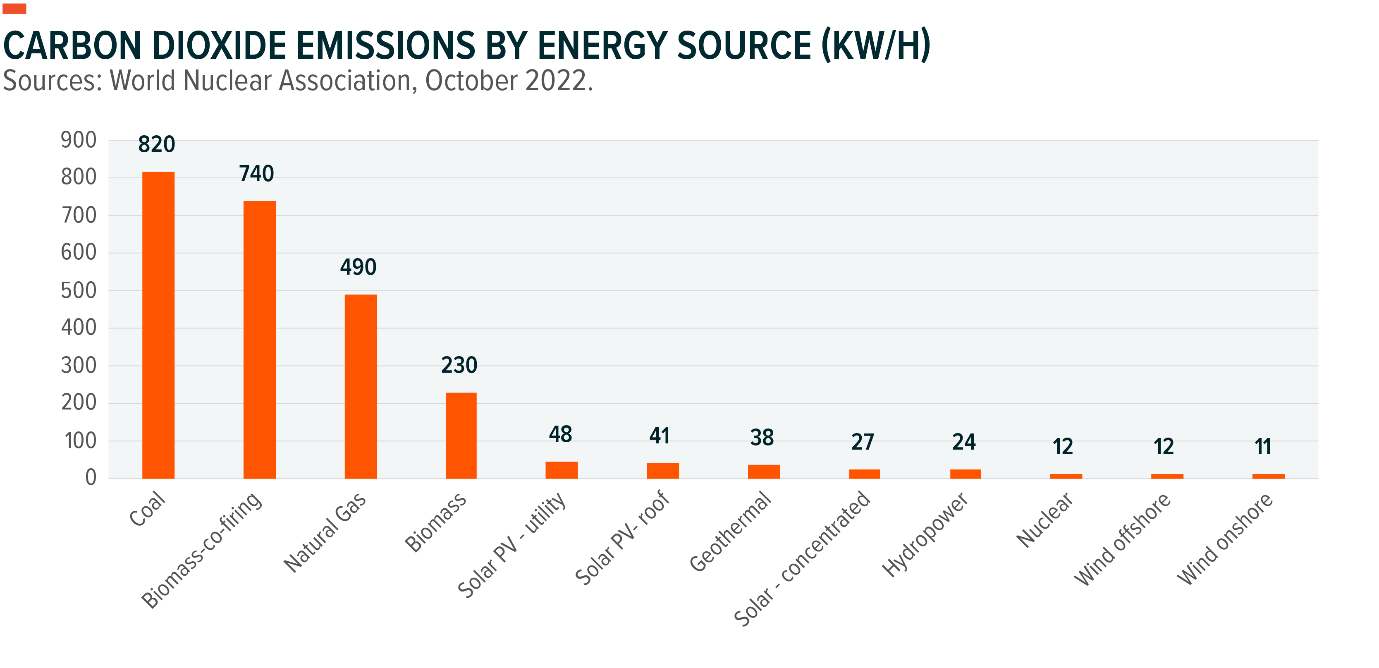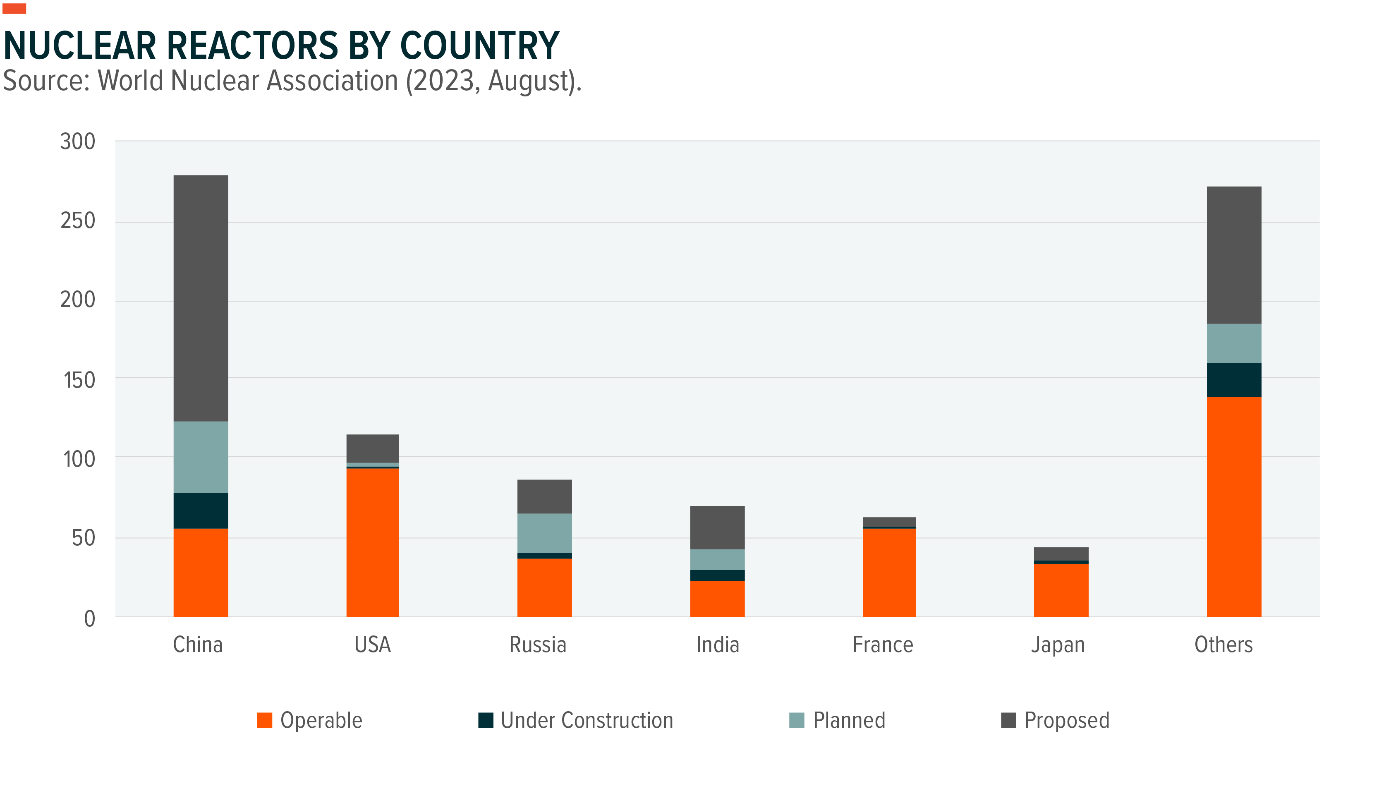Source: sharesmagazine
Date: Mar 13, 2024
Nuclear power, which uses uranium to produce electricity with a small carbon footprint, has been around for decades, but the technology and underlying commodity have experienced renewed interest as the world looks to transition away from fossil fuels and nations work to increase energy security. The shift from fossil fuels to green energy sources such as solar and wind is well underway but cannot happen overnight. Misalignment between periods of peak production and peak demand and expensive battery storage mean that there is still a need for on-demand power sources like nuclear to achieve net-zero emissions goals.
Nuclear power is a clean, efficient, and essential source of electricity used to meet the world’s growing energy demands. It can produce electricity at scale while minimizing greenhouse gas emissions. This helps countries expand their electricity grid and usage while limiting air pollution. In sum, nuclear is a crucial source in filling production gaps associated with the energy transition toward net-zero emissions.
Uranium Extraction
Uranium fuel enables nuclear power plants to generate electricity, and global nuclear power output primarily drives the demand for this commodity. A single uranium pellet, slightly larger than a pencil eraser, contains the energy equivalent of a ton of coal, three barrels of oil, or 17,000 cubic feet of natural gas.1 Uranium is a heavy, dense, and radioactive metal, making it a potent source of energy. Uranium extraction generally involves recovery from the ground using open-pit mining, underground mining, or in-situ leach (ISL) methods.2 ISL, which involves pumping a solution called a lixiviant into the ground to dissolve the uranium and separate it from the rest of the rock formation, is the preferred method of extraction, as it is more cost effective and environmentally friendly than open-pit or underground mining.3
Uranium can be found in many parts of the world, but Kazakhstan, Canada, Namibia, and Australia were the top producers in 2022.4
From Metal to Electricity
Nuclear power remains one of the few sources of electricity that combines large-scale power output and low greenhouse gas emissions, with costs comparable to those of traditional fossil fuel power stations.5 Similar to coal or natural gas power plants, nuclear reactors generate electricity by producing immense heat. This heat produces steam, which propels a turbine connected to an electric motor. As the turbine rotates, the electric motor produces electricity. In nuclear power stations, however, the heat is generated from splitting uranium-235 atoms in the process of nuclear fission, as opposed to burning fossil fuels.6
Nuclear fission produces thousands of times more energy than that released through the process of burning similar amounts of fossil fuels, making nuclear power a very efficient method of generating utility-scale power.7 Additionally, the ongoing fuel costs for nuclear power plants tend to be quite low, due to the minimal amount of material needed to power the plant.

The Outlook for Uranium Demand
Geopolitics have roiled energy markets recently, and ambitious net-zero emissions targets may be difficult to reach with solar and wind power alone. As a result, many economies are reconsidering nuclear power as another source of green energy. As of August 1, 2023, there were 436 operable reactors globally accounting for 10.0% of global electricity generation and 60 reactors under construction.8 Emerging economies such as China and India are leading the charge, as increased demand primarily derives from countries with large populations contending with the dual issues of substantial electricity requirements and escalating air pollution problems. The latter represents the world’s largest market for uranium, and China plans to expand its nuclear power capacity significantly. The Chinese government intends to invest $440 billion in nuclear reactors over the next 15 years, targeting the production of 200 gigawatts of nuclear energy by 2035.9 Increased uranium demand from new reactors could keep the price of the element elevated, especially with the advent of next-generation small modular reactor (SMR) technologies, which offer a safer and less expensive alternative to traditional nuclear power plants.10

With the demand for nuclear power rising, so are concerns about the global uranium supply chain. Spot uranium prices roughly doubled between January 2023 and January 2024 amid a host of favorable supply and demand dynamics.11 Sources of price pressures have varied, including lower production guidance from producers like Cameco, a coup in Niger raising concerns about output, and uranium physical funds becoming more active. In line to benefit from these price trends are uranium mining, enrichment, and nuclear component players, all of which contribute to the world turning to nuclear energy as a reliable and sustainable power source.
How to Invest in Uranium
Despite expected growth in nuclear power, and a correlative increase in uranium demand, gaining exposure to this element sometimes proves difficult. Uranium trades with thin liquidity on futures exchanges, and there are ownership restrictions related to its usage in weapons production. As a result, the nuances of gaining exposure to uranium increase in comparison to dealing in other more commonly traded commodities, such as oil or gold. Common solutions involve purchasing uranium mining stocks or exchange traded funds (ETFs) that own baskets of uranium mining stocks and/or producers of nuclear components. Individual uranium mining stocks potentially hold high idiosyncratic risks, but accessing the industry through a broad basket of uranium mining and nuclear component producer stocks globally could help mitigate some of these risks.
Individual stocks also potentially offer somewhat of a levered play on the underlying commodity price, given the high fixed costs associated with mining. Uranium mining stocks maintain a relatively high unsystematic risk, due to the esoteric nature of the industry. For this reason, we believe investing in uranium ETFs may provide an efficient and cost-effective method for accessing a diverse basket of companies involved in uranium mining and the production of nuclear components around the world.
Related ETF
The Global X Uranium UCITS ETF (URNU) provides investors access to a broad range of companies involved in uranium mining and the production of nuclear components, including those in extraction, refining, exploration, or manufacturing of equipment for the uranium and nuclear industries. Due to the substantial unsystematic risk associated with uranium mining stocks as a result of the industry’s specialized nature, URNU may be able to help diversify a portfolio.
Capital at risk: The value of an investment in ETFs may go down as well as up and past performance is not a reliable indicator of future performance.
Footnotes
- GE Hitachi Nuclear Energy. (n.d.) Nuclear power basics. General Electric. Accessed on April 19, 2022.
- Ulmer-Scholle, D. S. (2022, February 22). Uranium – how is it mined? New Mexico Bureau of Geology & Mineral Resources, New Mexico Tech.
- Ibid.
- Statista. (2023, May). Mine Production of Uranium in Major Countries Worldwide in 2022.
- World Nuclear Association. (2021, September). Economics of nuclear power.
- World Nuclear Association. (2022, February). What is uranium? How does it work?
- World Nuclear Association. (2021, September). Economics of nuclear power.
- World Nuclear Association. Data as of August 1, 2023.
- Murtaugh, D., & Chia, K. (2021, November 2). China’s climate goals hinge on a $440 billion nuclear buildout. Bloomberg.
- International Atomic Energy Agency. (2023, Sep 13). What Are Small Modular Reactors (SMRs)?
- International Monetary Fund, Global Price of Uranium [PURANUSDM], retrieved from FRED, Federal Reserve Bank of St. Louis on February 28, 2024.
The Global X UCITS ETFs are regulated by the Central Bank of Ireland.
This is a marketing communication.
Please refer to the relevant prospectus, supplement, and the Key Information Document (“KID”) of the relevant UCITS ETFs before making any final investment decisions.
Investors should also refer to the section entitled “Risk Factors” in the relevant prospectus of the UCITS ETFs in advance of any investment decision for information on the risks associated with an investment in the UCITS ETFs, and for details on portfolio transparency. The relevant prospectus and KID for the UCITS ETFs are available in English at www.globalxetfs.eu/funds.
Investment in the UCITS ETFs concern the purchase of shares in the UCITS ETFs and not in a given underlying asset such as a building or shares of a company, as these are only the underlying assets that may be owned by the UCITS ETFs.
A UCITS ETF’s shares purchased on the secondary market cannot usually be sold directly back to a UCITS ETF. Investors must buy and sell shares on a secondary market with the assistance of an intermediary (e.g. a stockbroker) and may incur fees for doing so. In addition, investors may pay more than the current net asset value when buying shares and may receive less than the current net asset value when selling them. Changes in exchange rates may have an adverse effect on the value price or income of the UCITS ETF.
Past performance of a UCITS ETF does not predict future returns. Future performance is subject to taxation which depends on the personal situation of each investor, and which may change in the future. Neither past experience nor the current situation are necessarily accurate guides to the future growth in value or rate of return of a UCITS ETF.
Investment may be subject to sudden and large falls in value, and, if it is the case, the investor could lose the total value of the initial investment. Income may fluctuate in accordance with market conditions and taxation arrangements. The difference at any one time between the sale and repurchase price of a share in the UCITS ETF means that the investment should be viewed as medium term to long term.
Any investment in a UCITS ETF may lead to a financial loss. The value of an investment can reduce as well as increase and, therefore, the return on the investment will be variable.
Global X ETFs ICAV is an open-ended Irish collective asset management vehicle issuing under the terms of its prospectus and relevant supplements as approved by the Central Bank of Ireland and is the issuer of certain of the ETFs where stated.
Global X ETFs ICAV II is an open-ended Irish collective asset management vehicle issuing under the terms of its prospectus and relevant supplements as approved by the Central Bank of Ireland and is the issuer of certain of the ETFs where stated.
Communications issued in the European Union relating to Global X UCITS ETFs are issued by Global X Management Company (Europe) Limited (“GXM Europe”) acting in its capacity as management company of Global X ETFs ICAV. GXM Europe is authorised and regulated by the Central Bank of Ireland. GXM Europe is registered in Ireland with registration number 711633.
Communications issued in the United Kingdom and Switzerland relating to Global X UCITS ETFs are issued by Global X Management Company (UK) Limited (“GXM UK”), which is authorised and regulated by the Financial Conduct Authority. The registered office of GXM UK is 77 Coleman Street, London, EC2R 5BJ, UK. Information about GXM UK can be found on the Financial Services Register (register number 965081).
Information for Investors in Switzerland
This is an advertising document. The state of the origin of the fund is Ireland. In Switzerland, the representative is 1741 Fund Solutions AG, Burggraben 16, CH-9000 St.Gallen. The paying agent is Tellco AG, Bahnhofstrasse 4, 6430 Schwyz.
The prospectus, the key information documents or the key investor information documents, the articles of association as well as the annual and semi-annual reports may be obtained free of charge from the representative.
Past performance is no indication of current or future performance. The performance data do not take account of the commissions and costs incurred on the issue and redemption of units.



